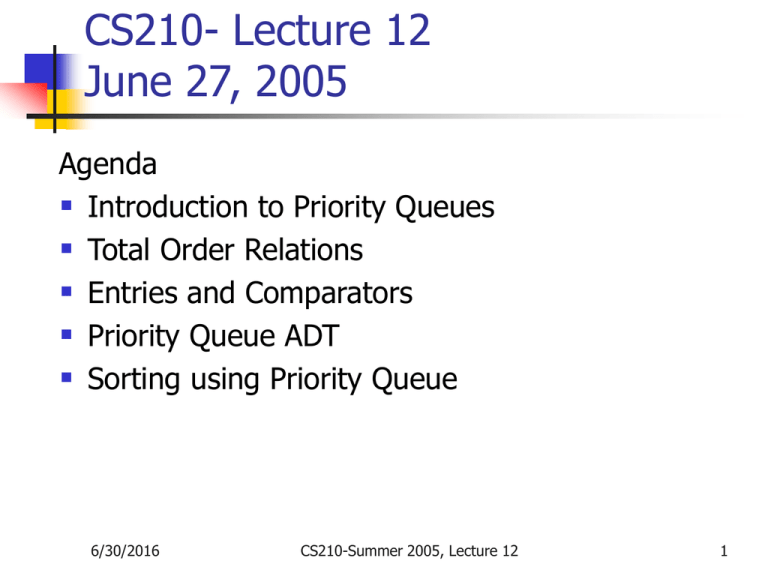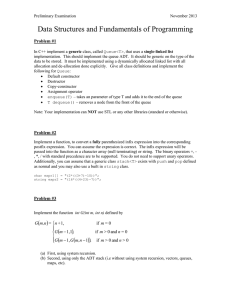CS210- Lecture 12 June 27, 2005
advertisement

CS210- Lecture 12
June 27, 2005
Agenda
Introduction to Priority Queues
Total Order Relations
Entries and Comparators
Priority Queue ADT
Sorting using Priority Queue
6/30/2016
CS210-Summer 2005, Lecture 12
1
Introduction
In this chapter, we study data
structures that store “prioritized
elements”.
Priorities can be viewed as arbitrary
objects as long as there is a consistent
way of comparing pairs of such objects
to see if one is less than or equal to the
other.
6/30/2016
CS210-Summer 2005, Lecture 12
2
Introduction
A priority queue is an abstract data type
for storing a collection of prioritized
elements that supports arbitrary
element insertion but supports removal
of elements in order of priority.
6/30/2016
CS210-Summer 2005, Lecture 12
3
Keys, Priorities and Total Order Relations
Applications commonly require that we
compare and rank objects according to
parameters or properties called keys
that are assigned to an element as a
specific attribute for that element.
The key an application assigns to an
element is not necessarily unique.
6/30/2016
CS210-Summer 2005, Lecture 12
4
Total Order Relations
Keys in a priority
queue can be
arbitrary objects
on which an order
is defined
Two distinct
entries in a
priority queue can
have the same
key
6/30/2016
Mathematical concept
of total order relation
Reflexive property:
xx
Antisymmetric property:
xyyxx=y
Transitive property:
xyyzxz
CS210-Summer 2005, Lecture 12
5
Comparing keys and total orders
A priority queue is a container of
elements, called values, each having an
associated key that is provided at the
time the element is inserted.
A key-value pair inserted into a priority
queue is called an entry of the priority
queue.
6/30/2016
CS210-Summer 2005, Lecture 12
6
Comparing keys and total orders
The two fundamental methods of a
Priority Queue P are as follows:
insert(k, x): insert a value x with key k
into P.
removeMin(): return and removes from P
an entry with the smallest key, that is, an
entry whose key is less than or equal to
that of every other entry in P.
6/30/2016
CS210-Summer 2005, Lecture 12
7
Entries and Comparators
There are still two important issues that
we have left so far:
How do we keep track of the association
between keys and values.
How do we compare keys so as to
determine a smallest value.
6/30/2016
CS210-Summer 2005, Lecture 12
8
Entry ADT
An entry in a priority
queue is simply a keyvalue pair
Priority queues store
entries to allow for
efficient insertion and
removal based on keys
Methods:
key(): returns the key
for this entry
value(): returns the
value associated with
this entry
6/30/2016
As a Java interface:
/**
* Interface for a key-value
* pair entry
**/
public interface Entry {
public Object key();
public Object value();
}
CS210-Summer 2005, Lecture 12
9
Comparator ADT
A comparator encapsulates
the action of comparing two
objects according to a given
total order relation
A generic priority queue
uses an auxiliary
comparator
The comparator is external
to the keys being compared
When the priority queue
needs to compare two keys,
it uses its comparator
6/30/2016
The primary method of the
Comparator ADT:
compare(x, y): Returns an
integer i such that i < 0 if a
< b, i = 0 if a = b, and i > 0
if a > b; an error occurs if a
and b cannot be compared.
CS210-Summer 2005, Lecture 12
10
Example Comparator
Lexicographic comparison of 2-D
points:
/** Comparator for 2D points under the
standard lexicographic order. */
public class Lexicographic implements
Comparator {
int xa, ya, xb, yb;
public int compare(Object a, Object b)
throws ClassCastException {
xa = ((Point2D) a).getX();
ya = ((Point2D) a).getY();
xb = ((Point2D) b).getX();
yb = ((Point2D) b).getY();
if (xa != xb)
return (xb - xa);
else
return (yb - ya);
}
}
6/30/2016
Point objects:
/** Class representing a point in the
plane with integer coordinates */
public class Point2D
{
protected int xc, yc; // coordinates
public Point2D(int x, int y) {
xc = x;
yc = y;
}
public int getX() {
return xc;
}
public int getY() {
return yc;
}
}
CS210-Summer 2005, Lecture 12
11
Priority Queue ADT
A priority queue stores a
collection of entries
Each entry is a pair
(key, value)
Main methods of the Priority
Queue ADT
insert(k, x)
inserts an entry with key k
and value x
removeMin()
removes and returns the
entry with smallest key
6/30/2016
Additional methods
min()
returns, but does not
remove, an entry with
smallest key
size(), isEmpty()
Applications:
Standby flyers
Auctions
Stock market
CS210-Summer 2005, Lecture 12
12
Priority Queue Sorting
We can use a priority
queue to sort a set of
comparable elements
1. Insert the elements one
by one with a series of
insert operations
2. Remove the elements in
sorted order with a series
of removeMin operations
The running time of this
sorting method depends on
the priority queue
implementation
6/30/2016
Algorithm PQ-Sort(S, P)
Input sequence S of elements
on which a total order relation
is defined, Priority Queue P
Output sequence S sorted by
the total order relation
while S.isEmpty ()
e S.removeFirst ()
P.insert (e, 0)
while P.isEmpty()
e P.removeMin ().key()
S.insertLast(e)
CS210-Summer 2005, Lecture 12
13
Implementing a Priority Queue with a List
Implementation with an
unsorted list
4
5
2
Performance:
3
1
insert takes O(1) time
since we can insert the
item at the beginning or
end of the sequence
removeMin and min take
O(n) time since we have
to traverse the entire
sequence to find the
smallest key
6/30/2016
Implementation with a
sorted list
1
2
3
4
5
Performance:
insert takes O(n) time
since we have to find the
place where to insert the
item
removeMin and min take
O(1) time, since the
smallest key is at the
beginning
CS210-Summer 2005, Lecture 12
14
Selection-Sort
Selection-sort is the variation of PQ-sort
where the priority queue is implemented
with an unsorted sequence.
Running time of Selection-sort:
1. Inserting the elements into the priority queue
with n insert operations takes O(n) time
2. Removing the elements in sorted order from the
priority queue with n removeMin operations
takes time:
O (n + n-1 + n-2 +….1)
Selection-sort runs in O(n2) time
6/30/2016
CS210-Summer 2005, Lecture 12
15
Selection-Sort Example
Input:
Sequence S
(7,4,8,2,5,3,9)
Priority Queue P
Phase 1
(a)
(b)
..
.
(g)
(4,8,2,5,3,9)
(8,2,5,3,9)
..
..
.
.
()
(7)
(7,4)
Phase 2
(a)
(b)
(c)
(d)
(e)
(f)
(g)
(2)
(2,3)
(2,3,4)
(2,3,4,5)
(2,3,4,5,7)
(2,3,4,5,7,8)
(2,3,4,5,7,8,9)
(7,4,8,5,3,9)
(7,4,8,5,9)
(7,8,5,9)
(7,8,9)
(8,9)
(9)
()
6/30/2016
()
(7,4,8,2,5,3,9)
CS210-Summer 2005, Lecture 12
16
Insertion-Sort
Insertion-sort is the variation of PQ-sort where the
priority queue is implemented with a sorted
sequence
Running time of Insertion-sort:
1.
Inserting the elements into the priority queue with n
insert operations takes time proportional to
1 + 2 + …+ n
2.
Removing the elements in sorted order from the priority
queue with a series of n removeMin operations takes
O(n) time
Insertion-sort runs in O(n2) time
6/30/2016
CS210-Summer 2005, Lecture 12
17
Insertion-Sort Example
Input:
Sequence S
(7,4,8,2,5,3,9)
Phase 1
(a)
(b)
(c)
(d)
(e)
(f)
(g)
(4,8,2,5,3,9)
(8,2,5,3,9)
(2,5,3,9)
(5,3,9)
(3,9)
(9)
()
(7)
(4,7)
(4,7,8)
(2,4,7,8)
(2,4,5,7,8)
(2,3,4,5,7,8)
(2,3,4,5,7,8,9)
Phase 2
(a)
(b)
..
.
(g)
(2)
(2,3)
..
.
(2,3,4,5,7,8,9)
(3,4,5,7,8,9)
(4,5,7,8,9)
..
.
()
6/30/2016
Priority queue P
()
CS210-Summer 2005, Lecture 12
18
In-place Insertion-sort
Instead of using an
external data structure,
we can implement
selection-sort and
insertion-sort in-place
A portion of the input
sequence itself serves as
the priority queue
For in-place insertion-sort
We keep sorted the initial
portion of the sequence
We can use swaps
instead of modifying the
sequence
6/30/2016
5
4
2
3
1
5
4
2
3
1
4
5
2
3
1
2
4
5
3
1
2
3
4
5
1
1
2
3
4
5
1
2
3
4
5
CS210-Summer 2005, Lecture 12
19



